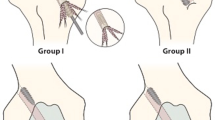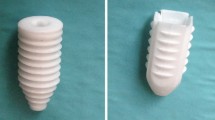Abstract
Purpose
The anterior cruciate ligament (ACL) reconstruction is one of the most performed and successful orthopaedic procedures. The results are considered independent by the choice of the graft and the fixation devices. A growing interest on resorbable non-metallic fixation devices versus standard metallic fixation devices has been noted over recent years with few clinical experiences reported in the literature. The aim of this study is to compare the clinical and radiological outcomes of patients undergoing ACL reconstruction using autologous hamstring tendons with tibial fixation by a centrally placed resorbable screw and sheath to a combination of an eccentrically placed resorbable interference screw and supplementary staple fixation.
Methods
Ninety patients undergoing an isolated, single-bundle, primary ACL reconstruction with autologous hamstring tendons, using the same femoral fixation, were randomized to a tibial fixation with a centrally placed resorbable screw and sheath, BioIntrafix (group A), or an eccentrically placed resorbable interference screw, BioRCI, and two non-resorbable staples (group B). The latter has represented for many years our standard fixation method. Clinical evaluations (KOOS, IKDC, KT-2000™ side-to-side difference) and radiological analyses were conducted in both groups with a minimum follow-up of 2 years.
Results
We assisted in a satisfactory pain relief and functional improvements, without significant clinical and radiological differences in both groups. No further surgery was needed in patients with the screw/sheath tibial fixation. Seven patients with the screw/staples tibial fixation needed the surgical removal of the fixation devices due to pes anserinus irritation or local infection years after the index operation. Other parameters such as the tunnel enlargement were not statistically different in the two groups.
Conclusions
Good clinical and radiological outcomes of ACL reconstruction by a screw/sheath tibial fixation have been reported showing comparable results with respect to screw/staples fixation. There were no failures associated with loss of fixation with either of tibial fixation methods. A fewer number of surgical removals of tibial devices were also recorded in patients treated by the screw/sheath fixation system, related to the absence of local intolerance or infection compared to subjects with a standard tibial fixation.


Similar content being viewed by others
References
Aga C, Rasmussen MT, Smith SD, Jansson KS, LaPrade RF, Engebretsen L, Wijdicks CA (2013) Biomechanical comparison of interference screws and combination screw and sheath devices for soft tissue anterior cruciate ligament reconstruction on the tibial side. Am J Sports Med 41:841–848
Bourke HE, Salmon LJ, Waller A, Winalski CS, Williams HA, Linklater JM, Vasanji A, Roe JP, Pinczewski LA (2013) Randomized controlled trial of osteoconductive fixation screws for anterior cruciate ligament reconstruction: a comparison of the Calaxo and Milagro screws. Arthroscopy 29:74–82
Brand J Jr, Weiler A, Caborn DN, Brown CH Jr, Johnson DL (2000) Graft fixation in cruciate ligament reconstruction. Am J Sports Med 28:761–774
Brand JC Jr, Pienkowski D, Steenlage E, Hamilton D, Johnson DL, Caborn DN (2000) Interference screw fixation strength of a quadrupled hamstring tendon graft is directly related to bone mineral density and insertion torque. Am J Sports Med 28:705–710
Brown GA, Pena F, Grontvedt T, Labadie D, Engebretsen L (1996) Fixation strength of interference screw fixation in bovine, young human, and elderly human cadaver knees: influence of insertion torque, tunnel-bone block gap, and interference. Knee Surg Sports Traumatol Arthrosc 3:238–244
Bunchner M, Schmeer T, Schmitt H (2007) Anterior cruciate ligament reconstruction with quadrupled semitendinosus tendon—minimum 6 year clinical and radiological follow-up. Knee 14:321–327
Caborn DN, Brand J, Nyland J, Kocabey Y (2004) A biomechanical comparison of initial soft tissue tibial fixation devices: the Intrafix versus a tapered 35-mm bioabsorbable interference screw. Am J Sports Med 32:956–961
Chalmers PN, Mall NA, Moric M, Sherman SL, Paletta GP, Cole BJ, Bach BR Jr (2014) Does ACL reconstruction alter natural history? A systematic literature review of long-term outcomes. J Bone Joint Surg Am 96:292–300
Chechik O, Amar E, Khashan M, Lador R, Eyal G, Gold A (2013) An international survey on anterior cruciate ligament reconstruction practices. Int Orthop 37:201–206
Chizari M, Snow M, Wang B (2009) Post-operative analysis of ACL tibial fixation. Knee Surg Sports Traumatol Arthrosc 17(7):730–736
Choi NH, Yoo SY, Victoroff BN (2013) Tibial tunnel widening after hamstring anterior cruciate ligament reconstructions: comparison between Rigidfix and Bio-TransFix. Knee 20:31–35
Crawford SN, Waterman MB, Lubowitz JH (2013) Long-term failure of anterior cruciate ligament reconstruction. Arthroscopy 29:1566–1571
Dave LY, Leong OK, Karim SA, Chong CH (2013) Tunnel enlargement 5 years after anterior cruciate ligament reconstruction: a radiographic and functional evaluation. Eur J Orthop Surg Traumatol 24:217–223
De Wall M, Scholes CJ, Patel S, Coolican MR, Parker DA (2011) Tibial fixation in anterior cruciate ligament reconstruction: a prospective randomized study comparing metal interference screw and staples with a centrally placed polyethylene screw and sheath. Am J Sports Med 39(9):1858–1864
Ettinger M, Schumacher D, Calliess T, Dratzidis A, Ezechieli M, Hurschler C, Becher C (2014) The biomechanics of biodegradable versus titanium interference screw fixation for anterior cruciate ligament augmentation and reconstruction. Int Orthop 38:2499–2503
Ferretti A, Monaco E, Giannetti S, Caperna L, Luzon D, Conteduca F (2011) A medium to long-term follow-up of ACL reconstruction using double gracilis and semitendinosus grafts. Knee Surg Sports Traumatol Arthrosc 19:473–478
Foldager C, Jakobsen BW, Lund B, Christiansen SE, Kashi L, Mikkelsen LR, Lind M (2010) Tibial tunnel widening after bioresorbable poly-lactide calcium carbonate interference screw usage in ACL reconstruction. Knee Surg Sports Traumatol Arthrosc 18(1):79–84
Gwynne-Jones DP, Draffin J, Vane AG, Craig RA, McMahon SF (2008) Failure strengths of concentric and eccentric implants for hamstring graft fixation. ANZ J Surg 78:177–181
Harvey A, Thomas NP, Amis AA (2005) Fixation of the graft in reconstruction of the anterior cruciate ligament. J Bone Joint Surg Br 87:593–603
Hegde AS, Rai DK, Kannampilli AJ (2014) A comparison of functional outcomes after metallic and bioabsorbable interference screw fixations in arthroscopic acl reconstructions. J Clin Diagn Res 8:LC01-03
Hill PF, Russell VJ, Salmon LJ, Pinczewski LA (2005) The influence of supplementary tibial fixation on laxity measurements after anterior cruciate ligament reconstruction with hamstring tendons in female patients. Am J Sports Med 33:94–101
Iorio R, Vadalà A, Argento G, Di Sanzo V, Ferretti A (2007) Bone tunnel enlargement after ACL reconstruction using autologous hamstring tendons: a CT study. Int Orthop 31:49–55
Irrgang JJ, Ho H, Harner CD, Fu FH (1998) Use of the International Knee Documentation Committee guidelines to assess outcome following anterior cruciate ligament reconstruction. Knee Surg Sports Traumatol Arthrosc 28:392–399
Kousa P, Järvinen TL, Pohjonen T, Kannus P, Kotikoski M, Järvinen M (1995) Fixation strength of a biodegradable screw in anterior cruciate ligament reconstruction. J Bone Joint Surg Br 77:901–905
Kousa P, Järvinen TL, Vihavainen M, Kannus P, Järvinen M (2003) The fixation strength of six hamstring tendon graft fixation devices in anterior cruciate ligament reconstruction. Part I: femoral site. Am J Sports Med 31:174–181
Kousa P, Järvinen TL, Vihavainen M, Kannus P, Järvinen M (2003) The fixation strength of six hamstring tendon graft fixation devices in anterior cruciate ligament reconstruction. Part II: tibial site. Am J Sports Med 31:182–188
Laupattarakasem P, Laopaiboon M, Kosuwon W, Laupattarakasem W (2014) Meta-analysis comparing bioabsorbable versus metal interference screw for adverse and clinical outcomes inanterior cruciate ligament reconstruction. Knee Surg Sports Traumatol Arthrosc 22:142–153
L’Insalata JC, Klatt B, Fu FH, Harner CD (1997) Tunnel expansion following anterior cruciate ligament reconstruction: a comparison of hamstring and patellar tendon autografts. Knee Surg Sports Traumatol Arthrosc 5:234–238
Lubowitz JH, Appleby D (2011) Cost-effectiveness analysis of the most common orthopaedic surgery procedures: knee arthroscopy and knee anterior cruciate ligament reconstruction. Arthroscopy 27:1317–1322
Laxdal G, Kartus J, Eriksson BI, Faxen E, Sernert N, Karlsson J (2006) Biodegradable and metallic interference screws in anterior cruciate ligament reconstruction surgery using hamstring tendon grafts: prospective randomized stusy of radiographic results and clinical outcome. Am J Sports Med 34(10):1574–1580
Lieber RL (1990) Statistical significance and statistical power in hypothesis-testing. J Orthop Res 8:304–309
Malek MM, DeLuca JV, Verch DL, Kunkle KL (1996) Arthroscopically assisted ACL reconstruction using central third patellar tendon autograft with press fit femoral fixation. Instr Course Lect 45:287–295
Mermerkaya MU, Atay OA, Kaymaz B, Bekmez S, Karaaslan F, Doral MN (2015) Anterior cruciate ligament reconstruction using a hamstring graft: a retrospective comparison of tunnel widening upon use of two different femoral fixation methods. Knee Surg Sports Traumatol Arthrosc 23:2283–2291
Moisala AS, Järvelä T, Paakkala A, Paakkala T, Kannus P, Järvinen M (2008) Comparison of the bioabsorbable and metal screw fixation after ACL reconstruction with a hamstring autograft in MRI and clinical outcome: a prospective randomized study. Knee Surg Sports Traumatol Arthrosc 16(12):1080–1086
Ntagiopoulos PG, Demey G, Tavernier T, Dejour D (2015) Comparison of resorption and remodeling of bioabsorbable interference screws in anterior cruciate ligament reconstruction. Int Orthop 39:697–706
Papalia R, Vasta S, D’Adamio S, Giacalone A, Maffulli N, Denaro V (2014) Metallic or bioabsorbable interference screw for graft fixation in anterior cruciate ligament (ACL) reconstruction? Br Med Bull 109:19–29
Pinczewski LA, Lyman J, Salmon LJ, Russell VJ, Roe J, Linklater J (2007) A 10-year comparison of anterior cruciate ligament reconstructions with hamstring tendon and patellar tendon autograft: a controlled, prospective trial. Am J Sports Med 35:564–574
Quatman CE, Paterno MV, Wordeman SC, Kaeding CC (2011) Longitudinal anterior knee laxity related to substantial tibial tunnel enlargement after anterior cruciate ligament revision. Arthroscopy 27:1160–1163
Roos EM, Roos HP, Lohmander LS, Ekdahl C, Beynnon BD (1998) Knee Injury and Osteoarthritis Outcome Score (KOOS) - development of a self-administered outcome measure. J Orthop Sports Phys Ther 28:88–96
Smith KE, Garcia M, McAnuff K, Lamell R, Yakacki CM, Griffis J, Higgs GB, Gall K (2012) Anterior cruciate ligament fixation: is radial force a predictor of the pullout strength of soft-tissue interference devices? Knee 19:786–792
Tetsumura S, Fujita A, Nakajima M, Abe M (2006) Biomechanical comparison of different fixation methods on the tibial side in anterior cruciate ligament reconstruction: a biomechanical study in porcine tibial bone. J Orthop Sci 11:278–282
Vuori I, Heinonen A, Sievänen H, Kannus P, Pasanen M, Oja P (1994) Effects of unilateral strength training and detraining on bone mineral density and content in young women: a study of mechanical loading and deloading on human bones. Calcif Tissue Int 55:59–67
Webster KE, Feller JA, Elliot J, Hutchison A, Payne R (2004) A comparison of bone tunnel measurements made using computed tomography and digital plain radiography after anterior cruciate ligament reconstruction. Arthroscopy 20(9):946–950
Xie X, Liu X, Chen Z, Yu Y, Peng S, Li Q (2015) A meta-analysis of bone-patellar tendon-bone autograft versus four-strand hamstring tendon autograft for anterior cruciate ligament reconstruction. Knee 22(2):100–110
Xie X, Xiao Z, Li Q, Zhu B, Chen J, Chen H, Yang F, Chen Y, Lai Q, Liu X (2015) Increased incidence of osteoarthritis of knee joint after ACL reconstruction with bone-patellar tendon-bone autografts than hamstring autografts: a meta-analysis of 1,443 patients at a minimum of 5 years. Eur J OrthopSurg Traumatol 25:149–159
Zantop T, Weimann A, Schmidtko R, Herbort M, Raschke MJ, Petersen W (2006) Graft laceration and pullout strength of soft-tissue anterior cruciate ligament reconstruction: in vitro study comparing titanium, poly-D, L-lactide, and poly-D, L-lactide-tricalcium phosphate screws. Arthroscopy 22:1204–1210
Acknowledgments
The authors wish to thank Marco Biondi,MD and Nicola Monteleone,MD for their precious contributions.
Author information
Authors and Affiliations
Corresponding author
Ethics declarations
Ethical standards
The authors’ Institutional Review Board approved the study and follow-up, respecting the criteria of the Declaration of Helsinki; all subjects accepted the proposed treatment and follow-up after an adequate information and consent.
Conflict of interest
The authors declare that they have no conflict of interest.
Rights and permissions
About this article
Cite this article
Carulli, C., Matassi, F., Soderi, S. et al. Resorbable screw and sheath versus resorbable interference screw and staples for ACL reconstruction: a comparison of two tibial fixation methods. Knee Surg Sports Traumatol Arthrosc 25, 1264–1271 (2017). https://doi.org/10.1007/s00167-016-4135-9
Received:
Accepted:
Published:
Issue Date:
DOI: https://doi.org/10.1007/s00167-016-4135-9




